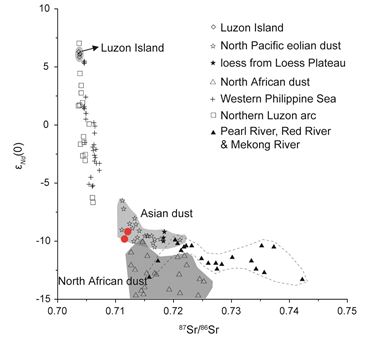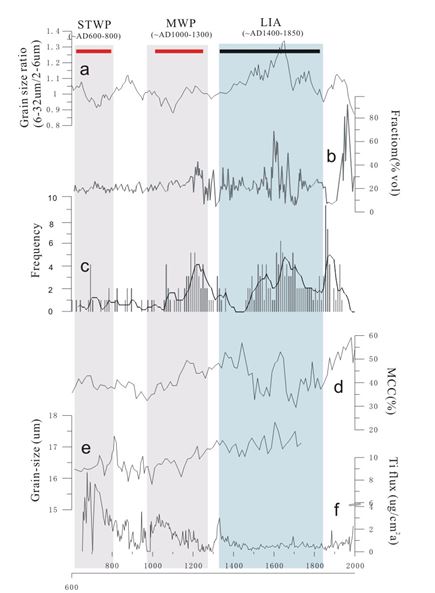
The Southern Edge of the East Asian Dust Storm
May 26, 2014 Email"> PrintText Size

It is said that Sherlock Holmes is so good at geology knowledge of London that he could deduce the place you came from just by a simple glance at the mud spot on your trousers. Unlike the famous detector, as a professor in University of Science and Technoloy of China (USTC), SUN Liguang and his team, however, deduced the fantastic source of the dust in South China Sea (SCS) after rigorous analysis into the precipitation on Dongdao Island, an elliptical island located in the north of SCS. The hometown of the dust precipitation, turned out to be the inland Asian. The dust travelled through the whole continent by dust storm.
The concentration of Ti, Al and the acidic insoluble particles in the lacustrine sediment core (DY6) collected in Dongdao Island play critical roles in SUN’s analysis. Results of element analyses indicate that the concentration of Ti and Al in DY6 are much higher than the background on the island. Morphological characteristics of acidic insoluble particles are similar to aeolian in East China. What’s more strange, Sr and Nd isotope compositions in these particles are consistent with those in Asian aeolian dust. As what Holmes said, “When you have eliminated all which is impossible, then whatever remains, however improbable, must be the truth”. Therfore, Professor SUN and his team has inferred that dust in DY6 may have been transported by East Asian Winter Monsoon (EAWM) from inland Asia.

Isotopes results of Sr, Nd in Asian, Africa terrigenous dust and SCS sediment; red points stand for the terriugenous source of the Dongdao lacustrine sediment core./Coutesy by SUN's group.
Based on the measured Ti flux, the continuous dust records for the past 1400 years in North SCS were also presented. Based on these data, they established the evolutionary trend of East-Asian winter monsoon in the past 1400 years. It’s the first proof that the dust from inland Asian could be transported to the Xisha Islands, by special transportation provided by the East Asian Winter Monsoon.

a,b,c,d,e are the dust or dust storm records in mid and high latitudes regions of East Asian for the past 1400 years; f is the record of Dongdao Island./Coutesy by SUN's group.
The paper has just be published on Scientific Reports, and the first author is Dr. YI Liu. This is not the first time for SUN’s team to unveil surprising results by research into seemingly unrelated materials. In 1998, SUN and his students went to the Antarctic Pole to search for sediments influenced by penguin droppings. Two years later, their paper released in Nature has been recognized as a new way to investigated penguins ecological archaeology. In 2003 and 2008, they search intoprecipitation in Xisha Islands also resulted in an astonishing new understanding in the mechanism of climate change in tropical Pacific region.
Today, 69-year-old SUN is still engaged in scientific research. With his novel methods, he and his team would unveal much more mysteries, just like the vigorous Holmes after extraordinary cases.
It is said that Sherlock Holmes is so good at geology knowledge of London that he could deduce the place you came from just by a simple glance at the mud spot on your trousers. Unlike the famous detector, as a professor in University of Science and Technoloy of China (USTC), SUN Liguang and his team, however, deduced the fantastic source of the dust in South China Sea (SCS) after rigorous analysis into the precipitation on Dongdao Island, an elliptical island located in the north of SCS. The hometown of the dust precipitation, turned out to be the inland Asian. The dust travelled through the whole continent by dust storm.
The concentration of Ti, Al and the acidic insoluble particles in the lacustrine sediment core (DY6) collected in Dongdao Island play critical roles in SUN’s analysis. Results of element analyses indicate that the concentration of Ti and Al in DY6 are much higher than the background on the island. Morphological characteristics of acidic insoluble particles are similar to aeolian in East China. What’s more strange, Sr and Nd isotope compositions in these particles are consistent with those in Asian aeolian dust. As what Holmes said, “When you have eliminated all which is impossible, then whatever remains, however improbable, must be the truth”. Therfore, Professor SUN and his team has inferred that dust in DY6 may have been transported by East Asian Winter Monsoon (EAWM) from inland Asia.

Isotopes results of Sr, Nd in Asian, Africa terrigenous dust and SCS sediment; red points stand for the terriugenous source of the Dongdao lacustrine sediment core./Coutesy by SUN's group.
Based on the measured Ti flux, the continuous dust records for the past 1400 years in North SCS were also presented. Based on these data, they established the evolutionary trend of East-Asian winter monsoon in the past 1400 years. It’s the first proof that the dust from inland Asian could be transported to the Xisha Islands, by special transportation provided by the East Asian Winter Monsoon.

a,b,c,d,e are the dust or dust storm records in mid and high latitudes regions of East Asian for the past 1400 years; f is the record of Dongdao Island./Coutesy by SUN's group.
The paper has just be published on Scientific Reports, and the first author is Dr. YI Liu. This is not the first time for SUN’s team to unveil surprising results by research into seemingly unrelated materials. In 1998, SUN and his students went to the Antarctic Pole to search for sediments influenced by penguin droppings. Two years later, their paper released in Nature has been recognized as a new way to investigated penguins ecological archaeology. In 2003 and 2008, they search intoprecipitation in Xisha Islands also resulted in an astonishing new understanding in the mechanism of climate change in tropical Pacific region.
Today, 69-year-old SUN is still engaged in scientific research. With his novel methods, he and his team would unveal much more mysteries, just like the vigorous Holmes after extraordinary cases.
CAS Institutes
There are 124 Institutions directly under the CAS by the end of 2012, with 104 research institutes, five universities & supporting organizations, 12 management organizations that consist of the headquarters and branches, and three other units. Moreover, there are 25 legal entities affiliated and 22 CAS invested holding enterprisesThere are 124 I...>> more
Contact Us

Chinese Academy of Sciences
Add: 52 Sanlihe Rd., Xicheng District, Beijing, China
Postcode: 100864
Tel: 86-10-68597592 (day) 86-10-68597289 (night)
Fax: 86-10-68511095 (day) 86-10-68512458 (night)
E-mail: cas_en@cas.cn

